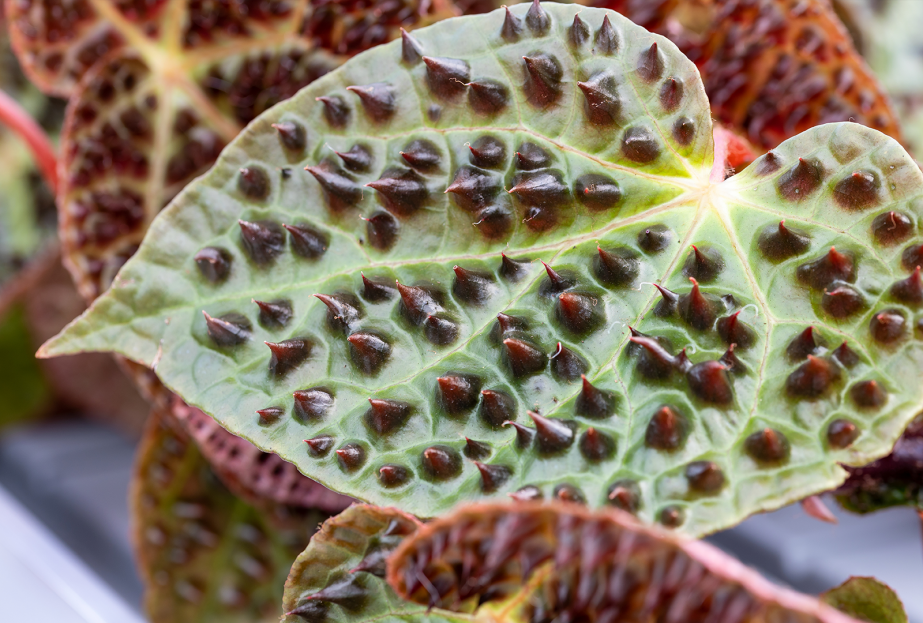
Begonia Ferox is an exotic and stunning plant that’s becoming increasingly popular in the world of houseplants. With its unique, spiny leaves and vibrant, reddish undertones, this begonia adds an interesting texture to any collection. Native to South America, Begonia Ferox is known for its striking foliage, which requires specific care to thrive indoors. Here’s how to properly care for your Begonia Ferox to ensure it grows beautifully.
Begonia Ferox thrives in bright, indirect light. While it can tolerate a bit of lower light, its growth may slow down, and its vibrant leaf color may not be as pronounced. Too much direct sunlight, however, can scorch the leaves, causing them to brown. For best results, place your Begonia Ferox near an east or west-facing window where it will receive filtered light. Avoid placing it in a dark corner or under direct, harsh sunlight for long periods.
Begonia Ferox has moderate watering needs, and like many begonias, it is quite sensitive to overwatering. The plant prefers the top inch of its soil to dry out before being watered again. Overwatering can lead to root rot and cause the leaves to yellow or drop off.
Water your Begonia Ferox with room-temperature water, ensuring the water drains freely from the pot’s drainage holes. During the growing season (spring and summer), water it more frequently, but cut back during the fall and winter when its growth slows. Always be sure not to let the plant sit in water, as stagnant water can cause root rot.
Begonia Ferox thrives in well-draining, slightly acidic soil. A good-quality, lightweight houseplant mix works well for this begonia. You can also add some perlite or coconut coir to improve drainage. It’s important to avoid compact soil, as it can cause the roots to suffocate and lead to root rot.
Choose a pot with proper drainage holes to prevent water from accumulating at the bottom. When repotting, opt for a pot that’s only slightly larger than the current one, as begonias prefer being a little root-bound. Repot your Begonia Ferox every 1-2 years to refresh the soil and allow for healthy root development.
Begonia Ferox prefers moderate to warm temperatures, typically between 65°F and 75°F (18°C to 24°C). Avoid placing it in areas that get too hot or cold, and keep it away from drafts, as extreme temperature changes can stress the plant.
This begonia is also sensitive to dry air, so it will thrive in humid environments. To maintain optimal humidity levels (around 50-60%), consider misting the plant occasionally, placing it on a humidity tray, or using a humidifier. If your home tends to be dry, especially during winter, boosting the humidity will help the Begonia Ferox grow healthily and maintain its lush foliage.
Begonia Ferox isn’t a heavy feeder, but it will benefit from a little boost during the growing season. Use a balanced liquid fertilizer diluted to half strength and apply it once every 4-6 weeks during spring and summer. Be careful not to over-fertilize, as this can cause fertilizer burn and harm the plant.
In the fall and winter, when the plant is not actively growing, reduce or stop fertilizing your plant altogether. This gives the plant a chance to rest and recover.
Pruning Begonia Ferox is not always necessary but can help maintain the plant’s shape and remove dead or damaged foliage. If any leaves become brown or damaged, cut them back with clean, sharp scissors to keep the plant looking neat.
Begonias are also known for developing leggy growth, so feel free to prune long stems to encourage new, bushier growth. Regularly wipe the leaves with a soft, damp cloth to remove dust, which can block sunlight and hinder photosynthesis.
Begonia Ferox is non-toxic to pets, making it a safe option for homes with pets. However, it's always a good idea to monitor pets around plants, as ingestion of large amounts of any plant material can lead to digestive upset.